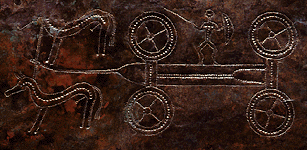Hochdorf: Bronze Couch
The "chieftain" was laid out on the couch, with his head toward the south, on thick layers of plant material and animal furs.
The entire couch, as restored.
Length: 2.75 m.


Back View

Front View
Much of the discussion surrounding the couch is informed by the question of the Celtic adoption of the Greek symposion. My composite shows the "chieftain" lounging on a bare couch -- in reality, it would have been well padded with natural fibers and textiles attached to rings at the back of the couch. The 35 cm height of the wheeled figures along the front has been considered too low for the couch to be sat on (Biel 1985, 101), and used as an argument in favor of a kline function. However, it seems to me that the height is perfectly adequate, if we do not require the knees to be bent at a precise right angle. Considering that, according to the ancient sources, most of any Trinkfest would be seated on the ground, even the comparatively slight elevation of the "chieftain" and of any persons privileged to sit with him would have had quite a powerful visual and spatial effect. North Italian situla art, specifically the Certosa situla, gives a vivid rendering of such seating arrangements on very similar furniture. Quibbles against the "kline" interpretation of the couch include the speculation that the incline of the seat toward the back, and the high sides and back, would be even more awkward for a reclining than for a seated person. The sides in particular do not accommodate the left elbow, as is essential in Greek kline construction, so that the symposiast may be propped up high enough to partake of the drink. Furthermore, the huge drinking horns, and the lavish meals consumed at the "Celtic" Trinkfest, require the use of both hands. In my opinion, the "chieftain" while alive used the couch as furniture to be sat on, not necessarily only at the Trinkfest, and that he was found reclining on the couch in the tomb not in imitation of Greek symposion practices, but because he was dead.
Impractical as the idea of reclining to feast on the couch may appear, it is the foundation of the theory, promoted esp. by Krauße, that the Hallstatt "Celts" adopted the Greek symposion in a conscious and strenuous attempt to become Hellenized. They did not, the theory goes, observe and imitate the Near Eastern practice of reclining and the Scythian-Eurasian use of the drinking horn directly; instead, they imitated the Etruscan version of the Greek symposion in the fond delusion that it was "genuinely" Greek, and thus desirable (1993, 188 ff.). Krauße reveals an unspoken Helleno-snobbism in his persistent if unsupported desire to see barbarian Eastern practices transmitted to the "Celts" through the civilizing mediation of the Greeks:
The path of the kline fashion can thus be followed effortlessly from Asia Minor via Greece and Italy into the centers of West Hallstatt culture. In the context of the large amount of Etruscan and Greek bronze dinnerware the was placed in the tomb with the Hochdorf "Celtic prince," it is not surprising that not only portions of the sets of drinking dishes, but also Mediterranean drinking practices, such as the reclining on klinai, were also adopted.
While we are thus (somit) enabled to definitively rule out a direct Scythian or nomadic origin for the Hochdorf Kline ... (note; 1993, 190)
While we are thus (somit) enabled to definitively rule out a direct Scythian or nomadic origin for the Hochdorf Kline ... (note; 1993, 190)
Details of scene incised into the back.




Wagon and two horses; warrior with shield and weapon
Wagon scene before restoration
Dagger-wielding dancers
Dancers scene, different view





Details of the bronze wheeled female figures, ca. 35 cm H (front of couch); ca. 32 cm H (back of couch). The figures are cast in robust arrangements of cylindrical and bulging forms. The surface articulation consists mainly of holes that, in many cases, apparently were inlaid with contrasting materials. The technique is not unknown in late Hallstatt Europe; see the fibula from Bohemia in the form of a female figure.


Left:A bronze fibula from Bohemia -- Manetin-Hradek (comparison)
Right: The Certosa situla from Northern Italy (information and comparisons)
Stuttgart: Württembergisches Landesmuseum.

